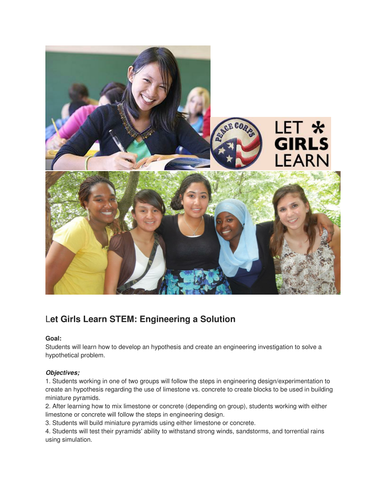
As part of the U.S. government's commitment to Let Girls Learn, First Lady Michelle Obama and the Peace Corps have formed a powerful collaboration to expand access to education for adolescent girls around the world. Educating girls is essential to healthy and thriving communities but, globally, 62 million girls are not in school, and barriers to adolescent girls completing school are particularly significant. In some countries, fewer than 10% of teenage girls complete secondary school.
This programme will address that challenge by empowering local leaders to put lasting solutions in place. Peace Corps Volunteers who live and work at the grassroots level will serve as catalysts of community-led change, and every American can get involved and make a difference.
https://letgirlslearn.peacecorps.gov/
FOR SCHOOLS FOR GIRLS AND OTHER EDUCATIONAL PROGRAMS SPECIFICALLY FOR GIRLS
Goal:
Students will learn how to develop an hypothesis and create an engineering investigation to solve a hypothetical problem.
Objectives:
1. Students working in one of two groups will follow the steps in engineering design/experimentation to create an hypothesis regarding the use of limestone vs. concrete to create blocks to be used in building miniature pyramids.
2. After learning how to mix limestone or concrete (depending on group), students working with either limestone or concrete will follow the steps in engineering design.
3. Students will build miniature pyramids using either limestone or concrete.
4. Students will test their pyramids' ability to withstand strong winds, sandstorms, and torrential rains using simulation.
5. Students will determine whether concrete or limestone were most likely used to build the Egyptian pyramids by using both to create mini-blocks and using them to create pyramids.
6. Students will record results using charts and anecdotal records.
7. Students will complete engineering a solution by working as a class by designing and building a prototype pyramid that can withstand salt water and aquatic conditions for the future scenario.
Something went wrong, please try again later.
This is a wonderful, hands-on resource that will test your students' engineering skills.
Report this resourceto let us know if it violates our terms and conditions.
Our customer service team will review your report and will be in touch.
$2.00
